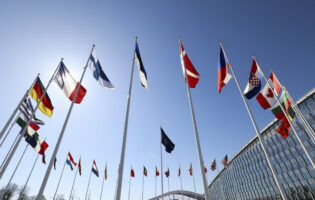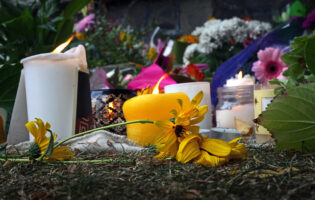Soft Power: Its Use in German and American Cultural Diplomacy

Frank Trommler
University of Pennsylvania
Frank Trommler is Professor Emeritus of German at the University of Pennsylvania, where he has been a member of the Department of Germanic Languages and Literatures since 1970. He has taught courses in German language, literature and culture in the nineteenth and twentieth centuries and, since 1985, also in Comparative Literature. He chaired the Department in 1980-86 and several times since 1994 as acting chair. In 1996-2000 he also served as acting chair of Penn’s Department of Slavic Languages.
A Guggenheim Fellow in 1984/85, Trommler was President of the AATG chapter Philadelphia in 1986-1990, President of the German Studies Association in 1991/92, and Director of the Humanities Program at the American Institute for Contemporary German Studies in Washington, DC, from 1995-2003. In 1994 he was awarded the Bundesverdienstkreuz by the President of the Federal Republic for his work in the field of American-German relations.
His publications include Roman und Wirklichkeit (1965), Sozialistische Literatur in Deutschland (1976), Die Kultur der Weimarer Republik (1978, with Jost Hermand, several reprints), America and the Germans (1985, also in German), Germanistik in den USA (1989), Thematics Reconsidered (1995), The Cultural Legitimacy of the Federal Republic (1999), Berlin: The new Capital in the East (2000), The German-American Encounter (2001, also in German), Weimars transatlantischer Mäzen: Die Lincoln-Stiftung 1927-1934 (2008). In 1995-2003 he edited fourteen volumes of the AICGS Humanities Series on Contemporary German Studies. A Festschrift in his honor appeared in 2004 under the title, The Many Faces of Germany, edited by John McCarthy, Walter Grünzweig, and Thomas Koebner.
Emeritus professor since 2007, Trommler published the first comprehensive study of German cultural diplomacy with France, Britain, United States, Russia, Poland, and Italy in 2014 under the title, Kulturmacht ohne Kompass: Deutsche auswärtige Kulturbeziehungen im 20. Jahrhundert (Cologne: Böhlau).
In 2014 he received the honorary degree of Doctor of Modern Languages at Middlebury College, Vermont, at the occasion of the 100th anniversary of the Middlebury Language School which was founded by the German professor Lilian Stroebe in 1915. The event united over a hundred MA and PhD graduates of the summer immersion programs in ten languages.
At an AGI workshop about Germany’s cultural policies in 1998, Harvard historian Charles Maier summarized his critical observations in one sentence: “Germany is a country that wants to run without a major-league foreign policy which means cultural representation, as well as political—but without the assets of empire, without the asset of Francophonie, without the asset of having a world language, the equivalent of Latin for the 20th century.”[1] Eight years after Germany’s reunification Maier gave much credit to Germany’s decentralized, yet effective system of creating cultural ties beyond its borders, but was less enamored with the definition of the German state as a Kulturstaat that would, by the magic of the word Kultur, have a positive impact on relations with other countries.
Maier shared the podium with the long-time administrator of foreign cultural policies in the German Foreign Ministry, Barthold Witte, who served as the Under Secretary of State between 1983 and 1992. Witte held on to the concept of Kulturstaat yet was not so sure about the efficient performance of the decentralized system. In his words: “While the British government entrusts one body—the British Council—with the task of managing its foreign cultural policy, Germany has a large number of organizations at work. Even experts like myself find it difficult at times to identify the right partner for a given project in this complex system.” Among these intermediary organizations the Goethe Institute, the German Academic Exchange Service (DAAD), and the Humboldt Foundation were mentioned as particularly prominent. Their contribution was included in Witte’s summary: “There is widespread agreement in Germany that foreign cultural policy has been very useful from its very start in bringing Germany back into the family of nations, in building confidence towards the new Germany.”[2]
These were memorable statements by a skeptical historian and a committed cultural politician, not without resonance today, seventeen years later. And yet, they have the sound of the 1990s when German foreign policy was, except for the full embrace of the European Union, a rather tentative enterprise, still trying to minimize the negative impact of the unification on other countries and searching for a new role in the world after severing the Cold War dependencies on the big powers in East and West. The historian pointed to the insecurities of Germans after Hitler and the Holocaust and saw their foreign policy still beholden to the legacy of that devastating history where the Kulturstaat tradition would not provide any redemptive strength; the cultural politician, instrumental in bridging the Cold War confrontations with cultural exchanges across the Iron Curtain, pointed to the successful role of German cultural intermediaries such as the Goethe Institute in the effort to reintegrate Germany in the democratic fabric of the West.
What has changed in the past seventeen years?
From Cultural Diplomacy to Soft Power
If one assembled a workshop in 2015, one would have to provide a prominent forum for the enormous growth of cultural diplomacy, especially with the new interest of the American government after the 9/11 terror attacks in counteracting the animosity, even hatred, of the U.S. in other parts of the world. As a part of it, a panel would focus on the spread of the concept of soft power that the political scientist Joseph Nye, using it first in 1990, popularized in a much quoted publication in 2004, defining soft power as the ability to affect others to obtain the outcomes one wants through attraction rather than coercion—in contrast to hard power and its instruments of military, political, and economic pressure.[3] As cultural diplomacy had lost urgency after the end of the Cold War confrontation and the disappearance of the communist use of arts, culture, and propaganda against the West, cultural and information agencies also lost support in Washington. In 1999, the premier institution, the United States Information Agency (USIA), was dissolved; the remnants were integrated in the State Department’s Bureau of Educational and Cultural Affairs. The interest in soft power after 9/11 helped expand budgets in the areas of education and cultural exchange again but did not diminish the traditional public suspicion that money spent abroad in this way was wasted as the effect remained mostly invisible. Still, the expansion in the various branches and programs of public diplomacy—the prevailing term for the instruments and actions of soft power[4]—was substantial, reaching around $500 million annually that mostly went to programs in scientific and academic exchange (including the flagship: the Fulbright Program), education, consulting, and other networks while the direct support of arts and culture programs remained small. Large private foundations such as Ford and Rockefeller, with a long tradition in international exchange, were joined by newcomers like the German Marshall Fund as substantial players in this field.
In the newer discussions of cultural diplomacy, the concept of soft power has made strong inroads also in Germany where the tradition of defining this field of action as foreign cultural policy (auswärtige Kulturpolitik) remains the guiding reference that ties it semantically to Kulturpolitik as an indispensable part of domestic policy. Given the vastly decentralized and, as Barthold Witte admitted, rather confusing network of German cultural agencies and intermediary organizations where the individual states (Länder) and cities have a strong presence, the term soft power, used in this context, promotes the association with softness that Germans like to attach to their dealings with other countries.
In Germany the end of the Cold War caused more than a rethinking of budget priorities. A whole German state—East Germany—with an extended system of cultural diplomacy disappeared from the European map. Another German state in the West, fully invested in promoting its achievements as a lively democracy, had to reissue its purpose beyond the reunification as a nation in Bismarck’s shadow. Maier and Witte only hinted at the lack of direction that characterized German cultural diplomacy in the later 1990s after the initial rush to expand the presence of a democratic Germany and the use of the German language to Eastern Europe. Before 1990 the mission of cultural agencies such as the Goethe Institute, though strongly opposed to tainting the cultural outreach with nationalism, had to be a kind of national reckoning with the sins of the past, thereby legitimizing the claim to present a new Germany to the world. This mission entailed constant rejection of the East German claims to represent another new Germany, yet it ended with the unification.
What was to be done after the fall of the Wall when this kind of reckoning did not provide enough of an agenda for dealing with other countries? Many actors set the sails on the European ship and opened their eyes to the need not only to intensify the cultural communication across borders, but also to transform the institutional make-up into a kind of service network for international or supra-national policies. Others felt rather unhappy about losing instruments—and budgets—for the wide-ranging cultural representation that centered around the core of German Kultur, including its current manifestations. When Joschka Fischer, the foreign minister in Gerhard Schröder’s coalition of SPD and Die Grünen, laid out the new direction in Konzeption 2000, he placed cultural diplomacy squarely within the new foreign policy agenda of crisis prevention, conflict resolution, and the promotion of peace, an agenda that the cabinet decreed in Aktionsplan Krisenprävention, Konfliktlösung und Friedensförderung in 2004. Foreign cultural policy was to generate instruments for a policy of crisis prevention and the promotion of human rights. Fischer presented this program as a confirmation of the increasing willingness of the Federal Republic to shoulder more responsibilities in the international arena, as manifested by committing the Bundeswehr to the Balkan conflicts that culminated in the NATO bombardment of Serbia in order to stop human rights abuses in Kosovo. Fischer showed little interest in the traditional forms of cultural outreach, reduced the budgets of the Goethe Institute and other organizations in this area, and increased the support for development projects, the dialogue and cooperation with Asian and African countries.
Critics often pointed to the fact that action committees and conferences were much more visible in promoting the agenda of crisis prevention and democracy building than the actual cooperation with other societies. Yet they could not deny that this revision of traditional cultural diplomacy around the turn of the twenty-first century helped build a basis of a new kind of German engagement in the increasingly globalized world. There can be no doubt that practicing internationalism, especially in the emotionally charged European neighborhoods, requires a lot of committees, commissions, and consulting bodies where administrators love to display their importance. However, the democratic ways of assembling multiple interests and arriving at consensus-driven programs that can be administered by corresponding bureaucracies favor these intermediary bodies. Germany, with its complicated arrangement of actors and budgets, is prone to going overboard with this kind of internationalist cultural bureaucracy. At the same time, one cannot deny that the country, second only after China as the world’s leading export nation, should be well equipped with a network of cooperative cultural, academic, and business organizations that help sustain this position and expand the flow of cultural communication with different regions of the world.
It goes without saying that the structures of these partly political, partly cultural, partly administrative operations do not differ much anymore between countries, although their domestic administrative and budgetary set-up—based on long and strongly defended traditions—may be quite varied. While the United States has been the leading force in providing new analytical tools and terms (as a Stichwortgeber), especially with the concepts of public diplomacy derived from the practice of the 1980s and soft power, it has been less willing to spend money—at least not the government’s—in creating or participating in institutions that submit to the label of culture as a political instrument. This has been rather a European domain, led by France, though European governments recently also have increasingly cut budgets and looked more aggressively for private sponsors, mostly for public-private partnerships in this realm. Sensing this trend, AGI in the late 1990s held several workshops that fostered exchange of American and German experts about applying American models of public-private sponsorship to Germany, where the state has traditionally provided the overwhelming share of cultural sponsoring.[5]
Public Diplomacy as Soft Power in the U.S. and Germany
Without engaging in a full-fledged comparison of the foreign ministries in the two countries, one can state that they claim a similar role in being responsible as the coordinators of the manifold institutions and activities, with an eye on their benefits for the actual foreign policy. In the course of the twentieth century American practices tended to either subsume public diplomacy firmly under the interests of the State Department, thereby frequently transgressing the borders toward outright propaganda, or to abandon this instrument of influencing foreign societies, leaving the action (and the financing) to private foundations. The example for firm submission was set by George Creel and his Committee on Public Information in 1917 whose task was “a vast enterprise in salesmanship, the world’s greatest adventure in advertising,” denigrating the German enemy and promoting the American idea of democracy and helping President Woodrow Wilson’s democracy mission gain broad public resonance also in Europe. The retreat from this policy occurred in the 1920s when the Carnegie Endowment and the Rockefeller Foundation established their own networks of cultural exchange and international cooperation with offices in Paris, involving (and sponsoring) the appropriate branches of the League of Nations. After 1945, fully engaged in the confrontations with the communist bloc, the government established the USIA, which developed effective strategies of soft power with Amerikahäuser and famous cultural ambassadors but did not shy away from an outright propaganda war with the Soviets.
In response to the 9/11 terror attacks, American debates centered around the right proportion of soft to hard power politics. Joseph Nye, constantly reassessing this relationship in light of the war against terrorism and discussing the right combination with the new term smart power, became increasingly skeptical: “Public diplomacy is an important tool in the arsenal of smart power, but smart public diplomacy requires an understanding of the role of credibility, self-criticism, and the role of civil society in generating soft power. Public diplomacy that degenerates into propaganda not only fails to convince, but can undercut soft power.”[6] Nye’s skeptical assessment received strong approval by Europeans. There was even a growing transatlantic consensus about the diminishing difference between soft and hard power. It was increasingly shaped by the fact “that the EU has over the last three decades increasingly gained confidence over the use of the coercive instruments it has always possessed—threats of economic sanctions—while also acquiring aspects of the traditional underpinning of statecraft, that is, military power.”[7] This process continues to unfold.
In contrast, after losing two devastating wars, the German state tended to conduct its foreign cultural policy in defensive ways, mostly through intermediary organizations (Mittlerorganisationen), probably the most appropriate instrument of soft power for a cultural diplomacy that was partly designed for mending fences with former enemies. Yet the two dictatorships under national socialist and communist regimes let the pendulum also swing to extremes: the complete submission of foreign cultural policies to the official governmental outreach to other countries. Under both regimes, the domestic and foreign cultural policies were tied together under one definition of culture, one national socialist, the other socialist. Aware of the destructive effects of Nazi cultural policies, the Foreign Ministry in Bonn let the intermediary organizations take the lead in articulating and practicing a more open and dialogical concept of cultural representation and exchange.[8]
Due to the broader exposure of Germany as a significant player in world politics after unification and the new obligations within the European Union, Joschka Fischer’s agenda made what had been an unreflected and unchallenged incarnation of soft power into a calculated tool—on the one hand more prominent as Germany’s contribution to internationalism, on the other more dependent on the increasingly supranational directives of European integration and outreach programs, NGOs, and other organizations. Not to forget direct interests of the foreign ministry, particularly in the field of development politics. The resumption of strong support for the more traditional branches of cultural representation after 2005—among them the Goethe Institute—under foreign minister Frank-Walter Steinmeier led to a more differentiated discussion of soft power that promises to facilitate longer-lasting effects than the mere agenda of crisis prevention as an early-warning system. At a much anticipated conference of major players in 2006, Christian Bode, then General Secretary of the German Academic Exchange Service (DAAD), summarized the intentions under the title “Kontinuität statt Krisenhektik.”[9] Bode stressed the importance of science and education programs as guarantors of long-term influence, pointing to the successful example of the DAAD in the worldwide competition of educational and scientific networks.
The consolidation of the various strands of foreign cultural policies is affecting the German use of soft power, yet the debates about the nature of this kind of power still tend to avoid hard political questions. Steinmeier’s strong commitment to cultural diplomacy has to be seen in the context of the more assertive role that the German government has begun to take in world politics. Foreign observers realize the balancing act. Their contrasting views show the range of reactions: on the one side, critics like the American Tony Corn with the verdict that “Germany is trying to force down the throat of Europe a federal political union which, for too many Europeans, eerily resembles a gentler, kinder Anschluss”[10]; and on the other side, the British Economist, which combined the observation about German pursuits of pacifism, yet economic dominion (“Paradoxically, the country that abhors nationalism is oddly national in its focus”[11]) with the charge that the country needs to take over more responsibilities in the current political crises. For the practitioners in Berlin, it might not suffice to point to the fact that Germany, according to the British Institute for Government, in 2013 took the third place in the “international ranking of soft power” after Britain and the United States.[12]
Dr. Frank Trommler is professor emeritus in the Department of Germanic Languages and Literatures at the University of Pennsylvania and an AGI Non-Resident Fellow.
[1] Charles Maier, “The American View: A Comment,” in The Cultural Legitimacy of the Federal Republic: Assessing the German Kulturstaat, ed. Frank Trommler (Harry & Helen Gray Humanities Program Series, vol. 6) (Washington, DC: Americn Institute for Contemporary German Studies, 1999), 60.
[2] Barthold Witte, “How to Present Germany as a Kulturstaat Abroad,” in The Cultural Legitimacy of the Federal Republic: Assessing the German Kulturstaat, ed. Frank Trommler, Harry & Helen Gray Humanities Program Series, vol. 6 (Washington, DC: Americn Institute for Contemporary German Studies, 1999), 54, 52.
[3] Joseph S. Nye, Soft Power. The Means to Success in World Politics (New York: Public Affairs, 2004).
[4] Hans T. Tuch, Communicating with the World. U.S. Public Diplomacy Overseas (New York: St. Martin’s Press, 1990); Geoffrey Cowan, Nicholas J. Cull, eds., Public Diplomacy in a Changing World, Annals of the American Academy of Political and Social Science vol. 616 (Philadelphia: Sage, 2008).
[5] Kulturkreis der deutschen Wirtchaft im BDI, ed., Bürger, Staat und Wirtschaft als Partner: Blaubuch des Aktionskreises Kultur (Bonn: ARCult Media, 1997).
[6] Josph S. Nye, “Public Diplomacy and Soft Power,” in Public Diplomacy in a Changing World, ed. Geoffrey Cowan, Nicholas J. Cull, Annals of the American Academy of Political and Social Science vol. 616 (Philadelphia: Sage, 2008), 108.
[7] Christopher Hill, “Cheques and Balances: The European Union’s Soft Power Strategy,” in Soft Power and US Foreign Policy: Theoretical, Historical and Contemporary Perspectives, eds. Inderjeet Parmar, Michael Cox (London/ New York: Routledge, 2010), 193.
[8] For a comprehensive overview of the developments in Germany in the twentieth century see my volume, Kulturmacht ohne Kompass: Deutsche auswärtige Kulturbeziehungen im 20. Jahrhundert (Cologne: Böhlau, 2014).
[9] Christian Bode, “Kontinuität statt Krisenhektik,” in Menschen bewegen – Kultur und Bildung in der deutschen Außenpolitik: Konferenzdokumentation 25-26 October 2006 (Berlin: Auswärtiges Amt, 2006).
[10] Tony Corn, “Toward a Gentler, Kinder German Reich? The Realpolitik behind the European Financial Crisis,” Small Wars Journal, 20 November 2011.
[11] Special Report GERMANY, Economist, 15 June 2013, 8.
[12] Kurt-Jürgen Maass, “Einleitung zur dritten Auflage,” in Kultur und Außenpolitik: Handbuch für Wissenschaft und Praxis, 3. Vollständig überarbeitete und erweiterte Auflage, ed. Kurt-Jürgen Maass (Baden-Baden: Nomos, 2015), 9. The volume, edited by the former director of the Institut für Auslandsbeziehungen in Stuttgart—now a Kompetenzzentrum of the Foreign Ministry—is the best compendium of current German cultural diplomacy, its institutions and structures.








